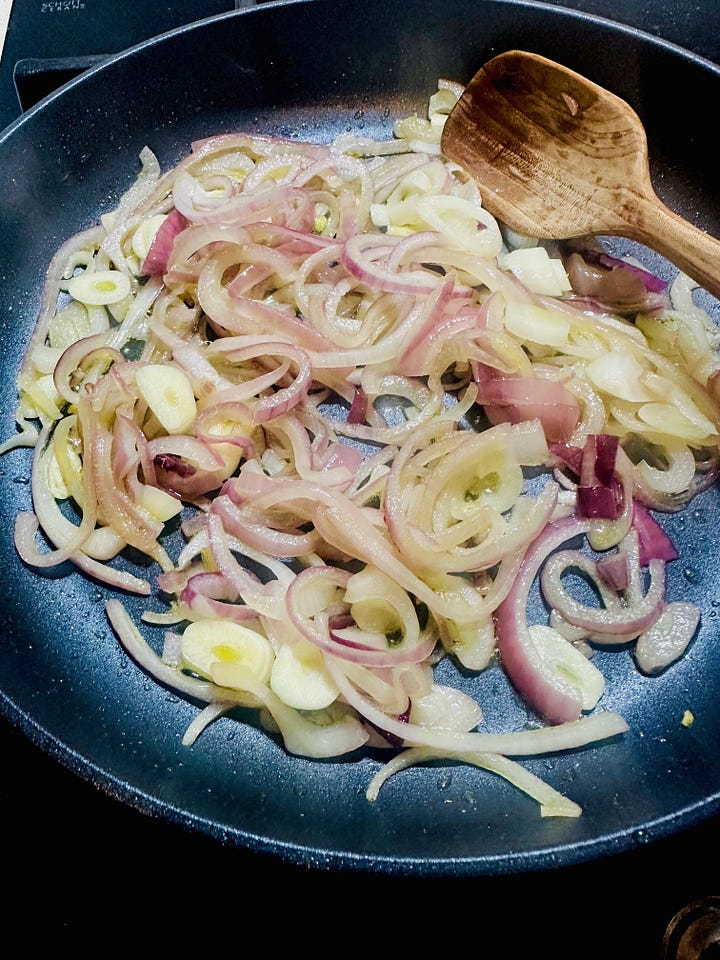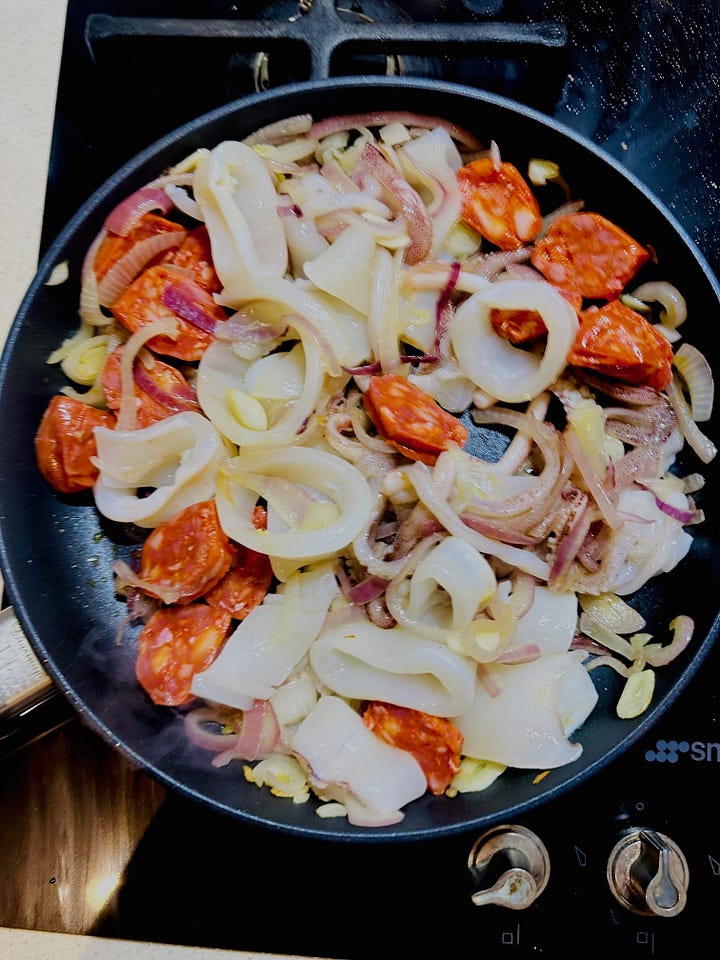Squid, or calamari, responds to being cooked very quickly or very slowly. Anything between is defiantly tough and rubbery, or as we restaurant critics like to say, ‘resilient’, so we don’t get sued.
The Squid Game headline is a cheap reference, not to the dystopian South Korean TV series that I am too scared to watch, but to the fact that I ran a recipe last year for flash-grilled squid (Squid Game, Episode 1). It was a masterclass in quick-and-fast, proving that pan-fried calamari should barely kiss the hot pan before it’s out again, so the muscle fibres don’t have time to contract and toughen.
Ah, but when you cook them longer and slower, the gentler heat breaks down the collagen and softens the texture instead of toughening it. Game on.
I love the Italian way of cooking ‘in umido’, which means to cook or stew in a sauce, as in umido = humid = damp = moist = liquid. You can cook polpette (meatballs) in umido, for instance, and seppie (cuttlefish). It’s a foolproof technique packed with flavour and pleasingly self-sufficient. You just leave everything alone for an hour, as if you’ve had an argument and you want them to stew on it.
This recipe started as a more traditional slow-cooked squid and peas (seppie in umido con piselli), but I’ve swapped out the peas for chickpeas, which seemed – in a kneejerk reaction – to call for chorizo sausage as well. This ‘let’s just add a chorizo’ seems to happen a lot at our place.
Feel free to revert back to the idea of squid and peas if you prefer - just chuck the peas in instead of the chickpeas for the last 10 minutes - and pick up on the dish’s Venetian vibe by ladling the stew over a puddle of polenta.
My goodness, it does smell heavenly, with that height of indefinable savoury sweetness that only ever seems to happen with long-cooked squid. It’s as if it has cooked itself into being more of itself, allowed to develop its full character. It’s the real squid, the full quid.
SQUID AND CHICKPEA STEW
1 onion
3 tbsp olive oil
2 garlic cloves, sliced
4 medium squid, thoroughly cleaned
1 fresh chorizo sausage, sliced
125 ml dry white wine
400 g canned tomatoes with juices (I used Mutti cherry toms)
1 tbsp tomato paste
150 ml water or stock
half tsp paprika
pinch of sugar
sea salt and pepper
400 g canned chickpeas, drained and rinsed
1 tbsp flat parsley leaves
Halve the onion and finely slice.
Heat the olive oil in a heavy-based pan, add the onion and garlic, and cook gently for 10 minutes without colouring.
Cut the squid bodies into 1.5 cm thick rings and cut each cluster of tentacles in two.
Add the squid and chorizo and fry for 2 minutes until lightly coloured, turning occasionally.
Add the white wine and let it bubble for a minute or two.
Add the tomatoes, tomato paste, water, paprika, sugar, salt and pepper, and simmer very gently for 45 minutes.
Add the chickpeas and simmer uncovered for 10 minutes or until the sauce is thick, rich and juicy.
Do a taste-test on the squid for tenderness, it may need another 10 minutes.
Scatter with parsley and serve. Serves 3 to 4.


HOW TO CLEAN SQUID (and why you need a chopstick)
+ Take over the kitchen sink. Set up a chopping board and knife next to it. Keep the paper the squid was wrapped in, to wrap up the innards.
+ Grasp the body in one hand and the head in another and gently twist and pull the head away and out of the body. It will come with innards attached, just leave them in the sink for now.
+ Gently pull the wing away from the body (and cook alongside). Peel off any skin.
+ Pull out the clear inner ‘quill’ and discard.
+ Cut off the tentacles just below the eyes, and squeeze to reveal the bony ‘beak’, the small sphere that pops out (it’s technically the collective mouth and anus, but you don’t need to now that at this stage). It’s inedible, so cut off and discard.
+ Gather up all the stuff that isn’t the tubes and tentacles (you’re keeping those), wrap in the paper and stow in the rubbish.
+ Rinse the tubes and tentacles well.
+ Just when you think you have finished, rinse the tubes again, digging right down to the tail end with a chopstick, and getting out the stuff that’s in there. Pat dry, and you’re ready to rock and roll.
Note that if you are slicing the tube into rings, the chopstick isn’t crucial because you can dig into the tail end and clean it out once cut.
Note that you can winkle out the silvery ink sacs from the innards and press them to release the ink into a tablespoon of water, to use in cooking risotto or pasta sauce. Wear gloves for this, or your fingernails will look like Frankenstein’s.
Note also that two of the arms/tentacles are exceptionally long - just snip them into manageable lengths.
Thanks for dropping by! And thanks for your comments; it’s so nice to have that small connection. Special thanks to Terry for the trip to the Fish Market; his Happy Place. Just noticed I tossed a bay leaf into the pot above as well; another knee-jerk reaction. Feel free to do the same.
I would like to acknowledge the traditional owners of the lands and waters upon which I work, live, cook and play; the Gadigal people of the Eora Nation. Thank you for sharing your culture, traditions, knowledge, spirit, art, music, humour and food traditions, allowing us all to experience a sense of belonging in this ancient land.






I love squid cooked like this. We've been making a version with mushrooms & spinach from Lorenza De Medici's - Italy The Beautiful Cookbook - for years and never tire of it. Looking forward to try yours (with the peas!)